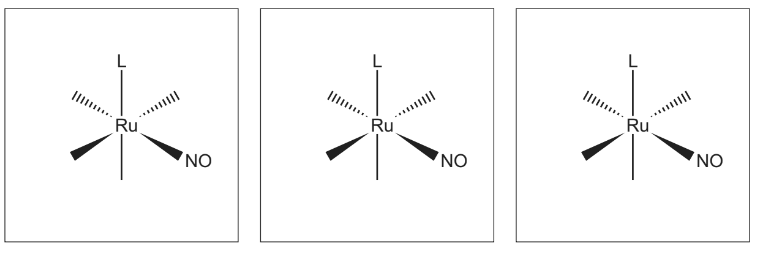Question
The transition elements are able to form stable complexes with a wide range of molecules and ions.
(a) State the meaning of transition element.
(b) The d orbitals in an isolated transition metal ion are degenerate. In complexes, the d orbitals occupy two energy levels.
(i) Complete the diagram to show the arrangement of d orbital energy levels in octahedral and in tetrahedral complexes.

(ii) Sketch the shape of two d orbitals:
● one d orbital from the lower energy level in an octahedral complex
● one d orbital from the higher energy level in an octahedral complex.
Use the axes below.

(c) Edds4- and edta4- are polydentate ligands that form octahedral complexes with Fe3+(aq).

The formulae of the complexes are [Fe(edds)]– and [Fe(edta)]– respectively.
(i) On the diagram of edds4- , circle each atom that forms a bond to the Fe3+ ion in [Fe(edds)]– .
(ii) [Fe(edds)]– is red and [Fe(edta)]– is yellow.
Explain why the two complexes have different colours.
State the type of reaction that occurs.
(iv) Write an expression for the stability constant, Kstab, of [Fe(edds)]– (aq).
(v) The table shows the values for the stability constants, Kstab, of both complexes.

Predict which of the [Fe(edds)]– and [Fe(edta)]– complexes is more stable.
Explain your answer with reference to the Kstab value for each complex.
(vi) When an excess of edta4-(aq) is added to [Fe(edds)]– (aq), the following equilibrium is established.
\([Fe(edds)]^{-}(aq) + edta^{4-}(aq) \rightleftharpoons [Fe(edta)]^{-} (aq) + edds^{4-}(aq)\)
Calculate the equilibrium constant, Kc, for this equilibrium, using the Kstab values given in
the table in (c)(v).
Answer/Explanation
Answer: (a) (element that forms one or more stable) ions with incomplete/ partially filled 3d-orbitals/d-subshell
(b)(i)
![]()
(b)(ii)

(c)(i) Circles round both N atoms and all four O–
(c)(ii) M1: (d–d) energy gap / ΔE is different M2: different frequency / wavelength (of light) absorbed
(c)(iii) ligand exchange / substitution / displacement / replacement
(c)(iv) 
(c)(v) [Fe(edta)]– is more stable as it has the higher Kstab
(c)(vi) ![]()
Question
(a) State one natural and one man-made occurrence of oxides of nitrogen.
(b) Under conditions of high pressure and a catalyst, nitrogen monoxide, NO, forms two other oxides of nitrogen, dinitrogen monoxide, N2O, and dinitrogen trioxide, N2O3.
…… NO(g) …… N2O(g) + …… N2O3(g) ΔHΘ= –195.2kJmol–1
ΔGΘ= –102.8kJmol–1
(i) Balance the equation above for the formation of N2O and N2O3 from NO.
(ii) State how the oxidation number of nitrogen changes during this reaction.
NO → N2O from ________________________ to ________________________
NO → N2O3 from ________________________ to ________________________
(iii) Calculate the entropy change for the reaction at 298K. Include the units in your answer.
(iv) State whether the sign of ΔSΘ calculated in (iii) agrees with that predicted from your balanced equation in (i). Explain your answer.
(c) At room temperature N2O3 dissociates.
N2O3(g) NO(g) + NO2(g)
(i) Write the expression for Kp for this equilibrium. Include the units in your answer.
A 1.00dm3 flask at 25°C is filled with pure N2O3(g) at an initial pressure of 0.60atm. At equilibrium, the partial pressure of NO2(g) is 0.48atm.
(ii) Calculate the partial pressures of NO(g) and N2O3(g) at equilibrium. Hence calculate the
value of Kp at 25°C.
(d) NO reacts readily with oxygen.
2NO(g) + O2(g) → 2NO2(g)
The table shows how the initial rate of this reaction at 25°C depends on the initial concentrations of the reactants.

(i) Deduce the order of reaction with respect to each reactant. Explain your reasoning.
order with respect to [NO(g)] ________________________________
order with respect to [O2(g)] _________________________________
(ii) State the rate equation for this reaction. Use the rate equation to calculate the rate constant.
Include the units for the rate constant in your answer.
(e) NO reacts with iron pentacarbonyl, Fe(CO)5, as shown. NO and CO are both monodentate ligands.
Fe(CO)5 + 2NO → Fe(CO)2(NO)2 + 3CO
During this reaction the co-ordination number of the iron changes.
(i) State what is meant by the term co-ordination number.
(ii) Describe how the co-ordination number of the iron changes during this reaction.
from ______________________ to _____________________
(iii) Only one stereoisomer of Fe(CO)2(NO)2 exists.
Use this information to suggest the geometry of the complex.
(f) The complex Ru(NO)L2Cl3 exists in three isomeric forms. L represents the monodentate ligand C6H5P(CH3)2.
(i) Complete the three-dimensional diagrams to show the three isomers of Ru(NO)L2Cl3.

(ii) Suggest the type of isomerism shown.
Answer/Explanation
Answer: (a) natural: lightning, bacterial decomposition, volcanic emissions
man-made: exhaust fumes, power stations, jet / car/ vehicle engines
(b)(i) 4NO → N2O + N2O3
(b)(ii) +2 to +1 AND +2 to +3
(b)(iii) ∆S = (∆H –∆G) / T
= (–195.2+102.8) / 298
= –0.310 kJ mol–1K–1
M1 numerical answer
M2 units
(b)(iv) yes as there is a decrease in no. of moles of gas
OR yes as moles of (gaseous) reactants is greater than moles of (gaseous) products
(c)(i) Kp = p(NO)p(NO2) / p(N2O3)
AND units: atm OR Pa
(c)(ii) M1
p(NO) = p(NO2) = 0.48 atm
p(N2O3)eqm = p(N2O3)o – 0.48 = 0.12 atm
M2
Kp = 0. 482 / 0.12 = 1.92 (atm)
(d)(i) M1 from 3rd and 1st rows as [NO] × 2 , rate increases × 4, so order = 2
M2 from 3rd and 2nd rows as [O2] × 2, rate also × 2, so order = 1
(d)(ii) rate =k[NO]2[O2]
k = rate / ([NO]2[O2]) = 3.5 / (0.01 × 0.05) = 7000 units: mol–2 dm6 s–1
(e)(i) the number of dative bonds formed with / by the central metal atom / ion
OR number of bonds between the ligands and the central metal atom / ion
(e)(ii) from 5 to 4
(e)(iii) tetrahedral
(f)(i)
(f)(ii) geometric(al) OR cis-trans